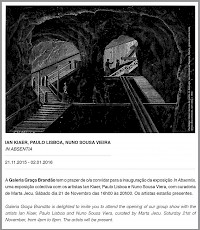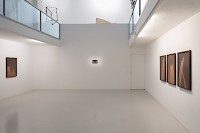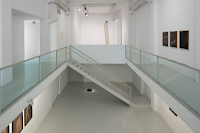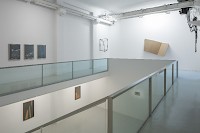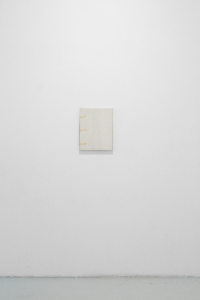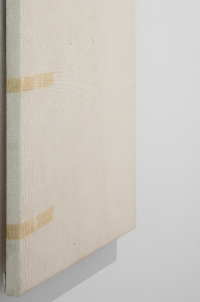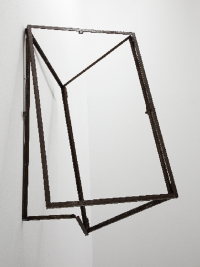Exhibition
IN ABSENTIA
21st November 2015 - 2nd January 2016
Galeria Graça Brandão, Lisboa
Artists: Paulo Lisboa, Ian Kiaer, Nuno Sousa Vieira.
Curator: Marta Jecu
IN ABSENTIA traces back the processes behind the emergence of mental and real artistic objects. The three invited artists go back to the past or associated forms of this quintessential object. Their thoughts, experiences, accidents, shifts and insights into genesis of their pieces make visible what is currently absent or remains mysterious in the object’s material form.
The artists attach many layers of significance to a single image or object. Through their work, the way in which the object is the result of the unpredictable connections that have happened in its past becomes obvious.
In this sense, the starting point for the exhibition is a reflection on the process of creation itself and the way in which previously unknown objects are constantly emerging. All of the artists have a conceptual approach to temporality, questions of spatial coherence and the essence of objecthood. Their work also induces a meditation on “the visible” and how it is experienced by each of us – as a quintessence of its past, historical and possible future forms.
Recurrently and melancholically, the three artists move back and forth between questions, places and structures that have been fundamental to their own process of creation. All of this material, which is essential for the creation of an artwork, stays hidden from its physical form. It becomes obvious how the object is a result of these threads of ideas connected to various cultural fields. “Deferred action”, something Hal Foster identified as a major cultural model, describes the recurrence of references in contemporary art since the start of modernism. In this sense, meaning is constructed not in a linear way, but rather sequentially. Each of the installations presented here chronicles the persistence of some of these reiterative diagrams of meaning. At the same time, they allow us to muse on the way in which the recurrence of fundamental preoccupations can become themes in the history of art.
These three installations aim to augment the viewer’s perception of the immaterial and virtual origins of an object or environment. The show also tries to stimulate curiosity about the nature of the artistic object. Moreover, it poses the question of how conceptual art can shape the transformation of a quotidian object in time and space. It reveals the modus operandi of what is called the post-conceptual artistic object: the fact that it has an agency and the specific way in which it influences the viewer.
'Documentation' of the artistic object, a very important methodology in Conceptualism, is seen as a process that has the power to reveal the creative substance that the object has accumulated over time, and becomes obvious in each of the presented installations.
As this exhibition is centered around the artists` personal parcourse of thoughts, their sources, documents and material of work, the following paragraphs quote smalls discussions had with the artists or written notes, book references that they have suggested and documentary material shared by them.
Ian Kiaer's work “Black Tulip, Sleep” evokes the ambient of experimental architecture of the 1960s and 1970s. Ant Farm (U.S.) and Archigram (UK), which programmatically turned with their inflatable bodies architecture towards a metamorphic structure, or even the sculptures of the German group Zero of the same decade (coming rather from conceptual minimalism) dismantled the self-assertive and dominating social presence of architecture. These experiments introduced a new duration in architecture, not only in regard to construction process and ephemeral use, but also regarding its persistence and its temporal orientation. As Kiaer explains, the inflatable structure is for him a notional model, that has a less aspirational disposition. In the same note, his monochromes lying on the ground imprint, in an equally temporal cadence, abandonment of progression and production. These are condensed moments in which activity ceases and passes to an unsubstantial form and agency.
The two carpet pieces in "Tooth house, carpet" were originally bought by Kiaer's grand parents in 1918 when they moved from Denmark to London. The carpet was gradually cut down as their means decreased and they were forced to move into ever smaller accommodation. His father had the last piece, from which originate the two offcuts presented here.
The two carpet fragments, recall for Kiaer Adorno's commentary (in “The Essay as Form”, 1958) on how due to their fragmentary nature, thoughts gain their precision as they cross, 'like a weave of a carpet'. In this sense, as remnants, they are just like the other pieces too, functioning both like an essential model, a conceptual form (and in this sense autonomous) and at the same time relational, as they are maintained through their fragmentary nature, connected to other configurations of meaning.
Paulo Lisboa started working with homogeneous black graphite surfaces close to the idea of mirror and reflecting on the nature of the medium itself, through drawing and experiments with light, film and projectors. Lisboa works with natural graphite (among other materials) which he extracts from an unknown well in a small Portuguese village, who's mention he found in the thesis of a Portuguese geologist from the 1970's. A piece installed in this exhibition, condenses his years long researches on the history of graphite, a material considered precious in the 17th century, when it was explored in Cumberland, England. The small original engraving PLUMBAGO was part of an encyclopedia edited 1865, and transports in the ambient of this show the context of the first universal exhibition of 1851 which displayed, among other 'wonders', sculpted blocks of graphite from a Siberian mine, explored by the French Jean Pierre Alibert, initially in search of a gold mountain supposedly located in Mongolia. Lisboa explains that his approach reveals affinities to geological processes: graphite is formed in the carbonic period around 380 million years ago, by contact metamorphism, resulting from exposure to the pressure and extreme temperature associated with a body of intruding magma. His conjoint of works invokes a telluric dimension, constantly moving tectonic plates and sedimentations. Layers of earth, dust and detritus which form graphite are present in his methodology of successive application of graphite powder and gradations. The here shown video extends into a philosophical and cosmic dimension these inquiries on materiality. Recorded in his atelier, it functions as a model of the principles of light circulation in a macro-cosmic frequency in which, as he explains, light is always present, always passing, but stays invisible unless encountering material points of reflection.
Nuno Sousa Vieira's double installation “Family Window” and “Family Sculpture” (whereas one represents the material vs. potential mirrored counterpart of the other) explore a principle of continuity and progression. In time and movement new forms unfold, that develop in relation to what has been previously present or in relation to what will be. Sousa Vieira extracts his idea of transmission from the theory of family resemblance of Ludwig Wittgenstein, a linguistic model that explains the evolution of families of words, not by linear transformation but by a row of overlapping patterns of similarities. The model was also applied on art historical theories from the beginning/middle of the 20th century*. The series of 3 drawings also present in this show are part of a conjoint of works named by Sousa Vieira “Origins”, which chronicle the mental place in which his creative processes ensue and gain presence. “Origins” is a self-referential map, a conceptual matrix, which recalls our latitude-longitude grids, but which, as Sousa Vieira explains, has is its own essential and primary nature, formed around ambiguous and sequential processes. They bring into presence the fact that we live in a permanent spatial and temporal displacement in relation to our referent points. “We are never in the right time with them. We are always arriving too late and there is always something that we realize we are loosing. These vestiges and reminiscences from our existential processes interest me. There is always this impossible adjustment between what we do and what we wanted to do or where we mentally are. These expectations interest me.” (Nuno Sousa Vieira)
* Carmo D`Orey, A exemplificacao na Arte. Um estudo sobre Nelson Goodman, Fundacao Caouste Gulbenkian, Lisboa, 1999
